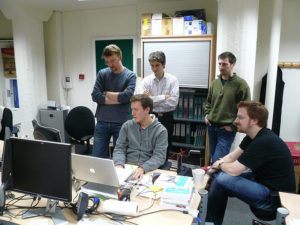In today’s workplace, it’s quite common to have employees spanning several generations working together. These include Baby Boomers (individuals born between 1948 and 1963), Generation X (born between 1964 and 1978), Millennials (born between 1979 and 1991), and Generation Z, which encompasses workers born after 1997.
With such a wide range of ages in one workplace, it’s possible to have a recent graduate in his or her early 20s working side-by-side with a 60+ Baby Boomer. As such, it is vital that human resources departments understand the specific needs of these particular demographics. Here, we’ll explore the best ways to promote collaboration among these groups and identify some key concerns HR teams need to know about.
Learn to Embrace Differences.

Image courtesy of Nestlé at Flickr.com
Successfully organizing a multigenerational workforce is a special challenge. From general work styles to personality types, every employee is unique. To create a cohesive working environment, HR professionals must not only recognize the differences inherent in each employee generation, they must also develop strategies for dealing with them.
One of the biggest hurdles that HR departments struggle to overcome in regards to a multigenerational workforce is stereotypes. Coworkers and management teams alike may knowingly or unknowingly perpetuate stereotypes or engage in negative generalizations, and this behavior is not limited to any single group. For example, older employees may have contempt for tech-focused millennials, while younger workers may resent older employees whom they view as change-averse know-it-alls.
HR professionals therefore need to implement appropriate sensitivity training to educate the workforce on these stereotypes and biases. Companies that do so can encourage employees to recognize and value differing perspectives, which leads to improved communication between the various age groups.
Use Technology to Bridge the Gap.
Like it or not, technology is moving at a rapid pace, and only those companies that can keep up will achieve and maintain success. For human resources professionals, technology has become a huge part of the recruiting process.
From finding applicants to conducting interviews, technology has gone from a novelty to a necessity. One survey indicated that 20 percent of job seekers won’t apply for a job if they can’t complete the application on a smartphone. Despite this, only 25 percent of companies have optimized their application processes for smartphone compatibility. Obviously, Millennials and younger individuals coming into the workforce are more comfortable with applying online or via smartphone, so the challenge for HR departments will be to reach older applicants who may view technology as a barrier to entry.
Another area in which human resources can utilize technology to benefit employees of all ages is scheduling. With a workforce of varying ages and experience levels, flexible scheduling is critical, and technology is a great way to simplify it. Many firms now use scheduling software, which helps employees decide when and how they work. This tool enables team members to make last-minute updates in real time and relieves leadership of having to deal with paperwork or unexpected schedule changes.
Manage Company Expectations.

Image courtesy of Lars Plougmann at Flickr.com
When trying to engage a multigenerational workforce, it’s important to temper company expectations. Older workers may be eligible for retirement, yet may still have many valuable working years ahead, so pushing them out the door is generally not a good idea. When this happens, HR departments unnecessarily impose hardships on individual business units that may be adversely impacted by what’s called “loss of knowledge.”
A “loss of knowledge” occurs when older generations leave the workplace, taking with them decades of experience that simply cannot be taught. Another point to consider is that when older employees do stay, they often face a dramatically increased workload because in addition to their regular duties, they are required to train younger employees while keeping up with constantly changing workforce dynamics. HR departments can help by managing expectations and instituting training that specifically addresses these issues.
One of the biggest conundrums of managing a multigenerational workforce is finding a way to determine the strengths and weaknesses of each employee. Discovering ways to provide consistent feedback and support will help management see each employee as an individual who brings something unique to the workplace. Respect for employees— regardless of their age—goes a long way towards ensuring a productive and happy workforce.

